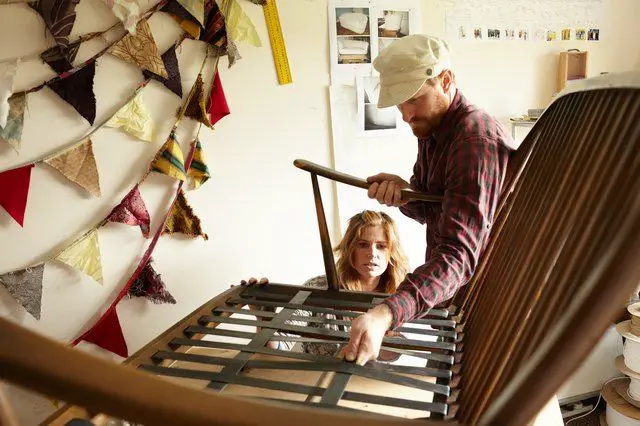The elastic webbing layer is attached to the wooden frame and present beneath the sofa’s seats to provide support.
However, the sofa’s webbing may break or get loose with time and make you feel uncomfortable sitting on the couch.
How to Replace Sofa Elastic Webbing? You can replace the sofa elastic webbing by removing the cushions, then remove the damaged webbing by removing its clip. Next, weave the sofa’s frame with new elastic webbing and secure it by using a stapler. Finally, incorporating the second layer of webbing over the first layer and place the cushions back.
You need to stretch and tighten the webbing of the couch to hold the sofa to make it straight.
Elastic webbing is a long strap interwoven with rubber and synthetic fiber. This material makes it more stretchable, durable, and resistant.
In addition, it does not quickly lose its strength and is not affected by water and temperature fluctuations.
Measure the size of the sofa
Measuring the size of the sofa is essential for the replacement of webbing straps. Take a
pen, paper, and measuring tape to measure the width and length of the couch.
Use the measuring tape and measure the length row-wise and width column-wise.
According to them, measuring the size of the sofa is necessary to purchase the rolls of elastic straps.
You can face a shortage of roll of webbing straps, and it becomes challenging to find the same quality and color again.
Remove the cushions from the sofa
After measuring the size, then remove the cushions of the couch to replace the webbing straps.
Webbing straps are present underneath the cushion to provide support to the sofa.
Remove the cushions of the couch carefully to prevent damage to its upholstery. The cushions’ fabric is attached to the bottom of the sofa with the help of a stapler.
Use a screwdriver to remove the pins and clips that are securing the material of upholstery seats.
Removal of dust and covers
The covers are present on the webbing; remove these covers and remove dust from them. Remove the dust by using a cloth and vacuum cleaner.
Remove the old straps
When you have removed the cushions, now check the old webbing straps of the couch.
Some straps get loose, and some are torn; you have to remove all of them. Now place the sofa upside down to remove the old straps.
Use a staple puller to remove the pins from the straps. After removing pins, remove all the old webbing.
Place all the pins in the bowl so children or pets cannot swallow them. Cut the extra webbing if it remains attached to the frame by using a scissor.
Fix the wooden frame
After you have removed all the old and torn straps from the couch, check the couch’s wooden frame.
Check the broken woods and the nuts or screws of the frame. If you find any broken wooden support, then fix it by using screws.
You cannot weave it in the broken wooden frame of the sofa. Therefore, before applying webbing straps, recheck the frame if any damage is present.
Attachment and securing of webbing straps
Put the webbing roll in the middle of the wooden frame to prevent them from tangling. Now open it and start from one side; place the strap width-wise.
Fill the stapler with attachment clips or pins to attach the elastic webbing traps with the frame. Start from the edge and put one end and secure them with a stapler.
Take a stretcher and stretch it in the opposite direction in the direction of your body. It helps to tighten the straps of the webbing.
It is better to take care that you do not pull its straps too hard. It will damage the wooden frame.
Now place the other end and also fix it with a stapler. Next, place the following straps 1 to 2 inches away from one another.
Weave the second layer of webbing
After applying the webbing straps in width, then use the elastic straps lengthwise. Fix them from both ends with the help of a stapler. Next, apply the second layer over and under the first layer.
Placement of cushions
After completing the above process, then cover the webbing with dust covers. Stapler the covers from the middle and edges to secure them.
Then place and fix the cushions on the frame of the sofa. The new straps support the couch and make you feel comfortable while sitting on it.
When and how often to replace sofa elastic webbing?
You can add the new webbing of the sofa when you feel your couch is sagging.
This sagging makes you feel uncomfortable sitting on the sofa. Moreover, you cannot sit on the sofa straight because its supportive material got damaged.
When you are sinking on the sofa, it is challenging for you to sit for a long time there.
Sagging in a leather sofa is due to the broken wooden frame. When the wooden frame of the couch is broken, fix it.
It is also because of torn or loose webbing of the sofa. When it is flexible, it cannot provide enough support to the couch.
When you put extra weight on the couch than its capacity, it tears the webbing straps.
You can replace this after 4 to 9 years to prevent from sagging of the couch. With only a little effort and expense, you can fix these issues.
Average cost and time required for this process
You required a maximum of 3 to 5 hours to remove the old webbing.
Therefore, the cost needed to replace them is between $50 to $250, and it varies due to the changes in the quality.
Related Articles:


